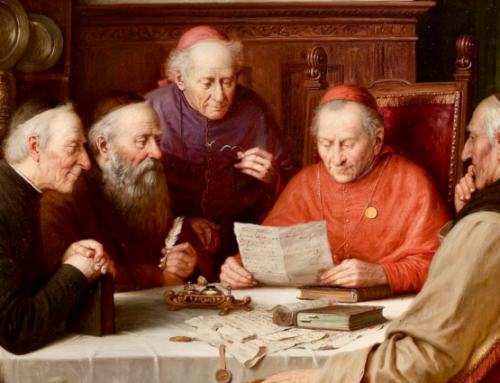Christian pilgrimage is not either a private or public affair—it is both. It is a work of God shot through with divine wisdom—begun, sustained, and guided by God’s providential love. When the Christian goes on pilgrimage, he participates in something greater than himself. He participates in the eternal designs of God’s heart.
This is part of a series entitled, “Pilgrimages: Paths We Tread.” Read the series introduction here. To see other posts in the series, click here.
 Christian pilgrimage is a dynamic reality–it is both private and public, a reflection of the Gospel message itself. It is the journey of an individual undertaken to speak more intimately with the indwelling God, the growth of divine friendship within the heart of the Christian. Yet going on pilgrimage is a public act—a journey transformed by grace that witnesses to the crucified, risen, and ascended Lord. It comes as no surprise, then, that God calls his child on pilgrimage to “go into all the world and proclaim the good news…” (Mark 16:15). It is precisely this public dimension of pilgrimage that I experienced firsthand when I walked the ancient way of Saint James (el Camino de Santiago, or “the Camino” for short) led by the witness and mark of millions of pilgrims before me.
Christian pilgrimage is a dynamic reality–it is both private and public, a reflection of the Gospel message itself. It is the journey of an individual undertaken to speak more intimately with the indwelling God, the growth of divine friendship within the heart of the Christian. Yet going on pilgrimage is a public act—a journey transformed by grace that witnesses to the crucified, risen, and ascended Lord. It comes as no surprise, then, that God calls his child on pilgrimage to “go into all the world and proclaim the good news…” (Mark 16:15). It is precisely this public dimension of pilgrimage that I experienced firsthand when I walked the ancient way of Saint James (el Camino de Santiago, or “the Camino” for short) led by the witness and mark of millions of pilgrims before me.
The Camino finds its origins with the discovery of the remains of the Apostle James, the son of Zebedee and brother of John. According to tradition, after the ascension of the Lord, Saint James traveled to the Iberian peninsula to preach the Gospel. Upon returning to Judea, James was the first of the apostles to be martyred by King Herod Agrippa I in 44 AD. James’ remains were taken back to the Iberian peninsula and buried in a field by some of his disciples only to be found by a shepherd some 800 years later.
Soon after the remains were discovered, King Alfonso II had a small chapel built which quickly became inadequate for the number of visiting pilgrims. A larger church was built and destroyed making way for the construction of the current Cathedral of Saint James in Santiago de Compostela, erected in 1075. The site has since attracted millions, and it remains incredibly popular with over 440,000 pilgrims completing it in 2023.
Desiring to go on a pilgrimage after graduating from college, and before I entered the Dominican novitiate, I decided to walk the Camino along the Portuguese coastal route. I had a week to walk about 60 miles from Valencia, Portugal, to the tomb of Saint James in Santiago de Compostela. The week of walking, praying, and thinking brought me great peace and clarity at a big moment of transition in life. I had a chance over that week to identify, remember, and thank God for his providential action in my life during my time in college. The rhythm of the days, the miles, and the steps fostered an atmosphere for contemplation—the love of God poured into my heart through the Holy Spirit who had been given to me (Rom 5:5). The contemplative routine was bringing about an interior stillness. But it was the public dimension of my pilgrimage that has remained with me most over the years.
After arriving in Santiago de Compostela and venerating the tomb of Saint James, my friend from college and I sat down to celebrate the completion of the Camino with a beer. As I ordered our drinks a local man made a beer suggestion, prompting a conversation which lasted well into the night. We talked about a lot of things, but one thing was certain: he was not a fan of the Church and did not believe in God. Over the hours, I shared that I was walking the Camino as a pilgrimage before I entered religious life. He couldn’t understand why someone in today’s day and age would be interested in giving their life to the Church. I spoke of God’s love, his Providence, his Goodness, and the reasonability of faith, seemingly to no avail. We parted ways, hours after that first comment at the bar, and he wished me well.
I don’t know what happened to that man, or whether there was something that I said that may have opened his mind and heart to the Lord, but I pray for him often. Upon reflection, this long conversation brought to mind a story of our Holy Father Dominic. On his way to officiate a marriage, and before he established the Dominican Order, Saint Dominic stopped at a tavern for some rest and ended up speaking with the innkeeper, an Albigensian heretic, through the night until in the morning the innkeeper declared his return to the true faith.
I didn’t spend the whole night speaking with this Spaniard, nor did he declare his return to the true faith, but the experience has stayed with me. While I’d thought my pilgrimage was over, God reminded me that the Christian life is not a private affair. God draws us closer to himself so that by our lives and words, we might draw others to the reality of the Lord Jesus who sits at the right hand of the Father, drawing all people to himself (John 12:32).
Christian pilgrimage is not either a private or public affair—it is both. It is a work of God shot through with divine wisdom—begun, sustained, and guided by God’s providential love. When the Christian goes on pilgrimage, he participates in something greater than himself. He participates in the eternal designs of God’s heart—designs that were hidden from ages and generations past but have been revealed to us in Christ (Ps 33:11; Col 1:26). Christian pilgrimage reveals the designs of God’s heart both to the Christian himself and to the world. But what exactly are the designs of God’s heart revealed to us in Christ? Jesus himself tells us when speaking to his Father: “…that they may be one even as we are one, I in them and you in me, that they may become perfectly one, so that the world may know that you have sent me and have loved them even as you have loved me” (John 17:22-23).
✠
Republished with gracious permission from Dominicana (February 2024).
The Imaginative Conservative applies the principle of appreciation to the discussion of culture and politics—we approach dialogue with magnanimity rather than with mere civility. Will you help us remain a refreshing oasis in the increasingly contentious arena of modern discourse? Please consider donating now.
The featured image is “A Building with a Blue Sign on the Side of it,” courtesy of Mor Shani.







Brother Arteaga,
I live in Santiago de Compostela, so a pleasure to read this tale from your pilgrimage!
I have benefited from reading this article. I knew there was a reason I didn’t delete it.
Brother Arteaga, what do you think about a secular Jewish friend who plans to walk a portion of the Camino with other, non-Catholic, non-religiously-affiliated friends? I was speechless when I heard their plans. One of them said something about not doing it for religious reasons, but because she heard that it can be spiritually rewarding.
Thank you for listening to the call of God for your life’s work. I am going on the Dynamic Catholic’s Camino in May. Your words will be my companion.